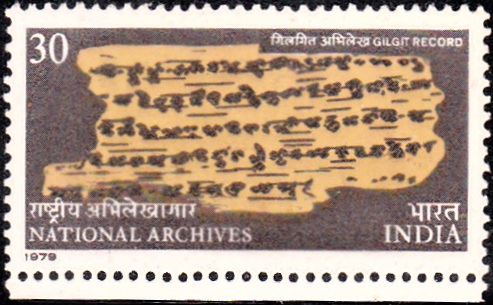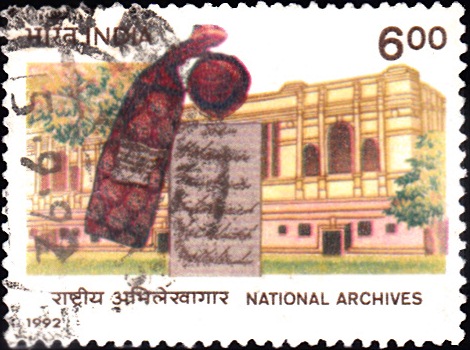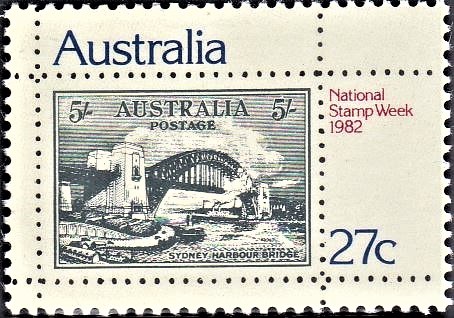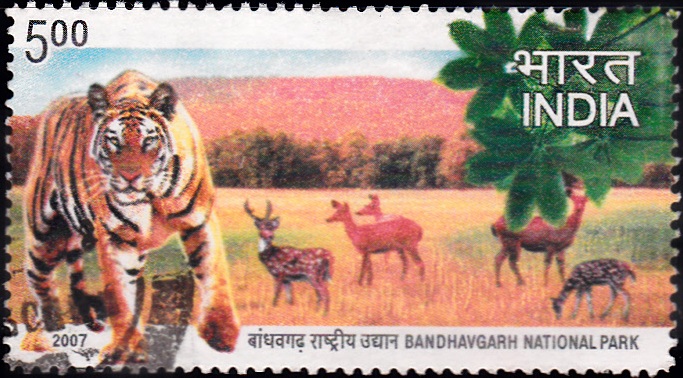
India on National Archives 1979
A commemorative postage stamp on the International Archives Week : National Archives of India (NAI), a repository of non-current records of Government of India :
Issued on Oct 23, 1979
Issued for : Indian Posts & Telegraphs Department honours all those who have been and are associated with preserving our documentary heritage for the posterity by issuing a special postage stamp during the International Archives Week.
Description of Design : The stamp depicts a part of the canonical text of the Mula Sarvastivada School of Buddhism on Birch bark. It is considered to be the earliest extant Indian manuscript and is written in Prakrit. It was found by Sir Aurel Stein in 1931 near Gilgit.
Type : Stamp, Mint Condition
Colour : Buff & Brown
Denomination : 30 Paise
Overall size : 4.06 X 2.28 cms.
Printing size : 3.80 X 2.00 cms.
Perforation : 14 X 14½
Paper : Printed on unwatermarked paper
Number printed : 30,00,000
Number per issue sheet : 50
Printing process : Photogravure
Designed and Printed at : India Security Press
About :
- The National Archives of India, established in Calcutta in 1891, was shifted to New Delhi in 1926. It is the national repository of rare and precious documents of historical interest. It’s collection runs over 25 kilometres of shelf space and has been regarded by the scholars as “probably the best historical material in the world”.
- The archival series begin from 1748 but the National Archives has acquired copies of documents relating to the first half of the eighteenth century. It has also acquired copies of documents of interest in private custody in countries like the United Kingdom, France, the Netherlands, etc. The documents in languages like Sanskrit, Persian, Bengali, Marathi, Telugu, Tamil, etc. make the collection a unique one as does over twenty thousand maps and memoirs prepared by Indian surveyors. It has also undertaken to acquire private papers of Indian luminaries like Dr. Rajendra Prasad, Maulana Abul Kalam Azad, Pandit Govind Ballabh Pant, Sarojini Naidu, etc. The varied nature of these documents and their subject matter add an immeasurable richness to the material which forms the source of research.
- The National Archives undertakes repair and conservation of documents by most modern and sophisticated methods and is constantly engaged in research to improve its methods. It has the distinction of developing ‘solvent lamination’ process for preserving brittle and fragile documents which has been hailed by archivists all over the world. Besides maintaining active liaison with Government Departments and advising them about maintenance and management of records, it also imparts training in ‘Archives Keeping’ through its Institute of Archival Training.


 Issued by
Issued by





Hello,
very very interesting
I`ll put link on my website to your site
regards Primoz
Hi Primoz,
Thanks for the good words. I would wait for the link love. I could also put a link to ur site from my resource page. Do let me know the page where u put my site-link.
Regards,
Ainy
[…] regular series in the National Archives of India begin from 1748 but the oldest document being preserved dates back to 1352 A.D. The total […]